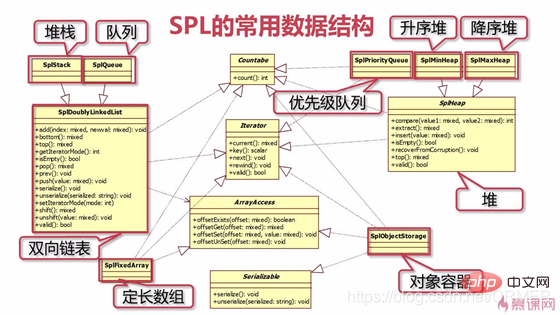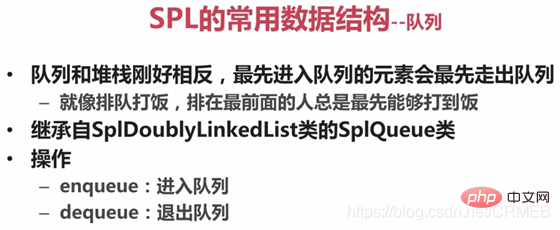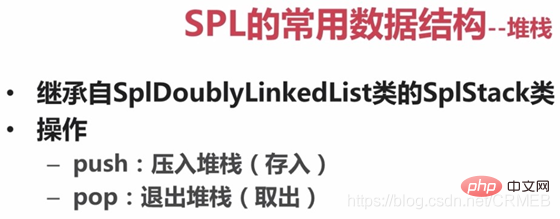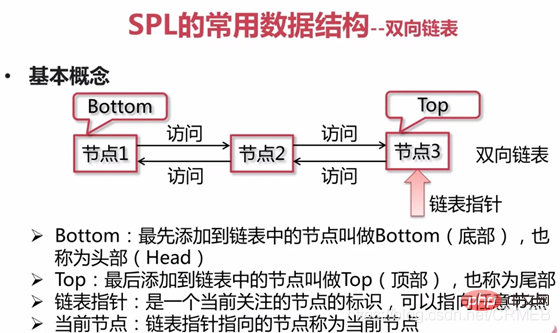Parsing the PHP standard library SPL data structure

SPL provides doubly linked lists, stacks, queues, heaps, descending heaps, ascending heaps, priority queues, fixed-length arrays, and object containers

SplQueue queue class
In and out, first in, first out

<?php$obj = new SplQueue();//插入一个节点到top位置$obj->enqueue(1);
$obj->enqueue(2);
$obj->enqueue(3);/**
SplQueue Object
(
[flags:SplDoublyLinkedList:private] => 4
[dllist:SplDoublyLinkedList:private] => Array
(
[0] => 1
[1] => 2
[2] => 3
)
)
*/$obj->offsetSet(0,'C');/**
SplQueue Object
(
[flags:SplDoublyLinkedList:private] => 4
[dllist:SplDoublyLinkedList:private] => Array
(
[0] => 'C'
[1] => 2
[2] => 3
)
)
*/$obj->rewind();//从队列中返回并删除bottom位置的元素$obj->dequeue();/**
'C'
SplQueue Object
(
[flags:SplDoublyLinkedList:private] => 4
[dllist:SplDoublyLinkedList:private] => Array
(
[0] => 2
[1] => 3
)
)
*/复制代码SplStack stack class
When entering and exiting single-ended, Last in, first out, first in, last out

$obj = new SplStack();/**
SplStack Object
(
[flags:SplDoublyLinkedList:private] => 6
[dllist:SplDoublyLinkedList:private] => Array
(
)
)
*///向堆栈放入一个节点到top位置$obj->push(1);
$obj->push(2);
$obj->push(3);/**
SplStack Object
(
[flags:SplDoublyLinkedList:private] => 6
[dllist:SplDoublyLinkedList:private] => Array
(
[0] => 1
[1] => 2
[2] => 3
)
)
*///堆栈的offset = 0 是Top所在的位置,offset = 1 是top节点靠近bottom位置的相邻节点$obj->offsetSet(0,'C');/**
SplStack Object
(
[flags:SplDoublyLinkedList:private] => 6
[dllist:SplDoublyLinkedList:private] => Array
(
[0] => 1
[1] => 2
[2] => 'C'
)
)
*/$obj->offsetSet(1,'B');/**
SplStack Object
(
[flags:SplDoublyLinkedList:private] => 6
[dllist:SplDoublyLinkedList:private] => Array
(
[0] => 1
[1] => 'B'
[2] => 'C'
)
)
*///堆栈的rewind使指针指向top节点,而双向链表的rewind指向bottom节点$obj->rewind();//堆栈的next是使指针向bottom方向相邻的节点移动一位,而链表是向top方向移动$obj->next();//遍历堆栈$obj->rewind();while($obj->valid()){ echo $obj->key().'=>'.$obj->current();
$obj->next();
}/**
2=>'C'
1=>'B'
0=>1
*///从堆栈中取出top位置的节点并删除$obj->pop();复制代码SplDoublyLinkedList Doubly linked list class

$obj = new SplDoublyLinkedList();//SplDoublyLinkedList Object ( [flags:SplDoublyLinkedList:private] => 0 [dllist:SplDoublyLinkedList:private] => Array ( ) )//把新的节点数据添加到链表的顶部Top$obj->push(1);
$obj->push(2);
$obj->push(3);//把新的节点数据添加到链表底部bottom$obj->unshift(4);/**
SplDoublyLinkedList Object
(
[flags:SplDoublyLinkedList:private] => 0
[dllist:SplDoublyLinkedList:private] => Array
(
[0] => 4
[1] => 1
[2] => 2
[3] => 3
)
)
*///在没有调用rewind()方法之前输出为nullecho 'current'.$obj->current();//输出: null//把指针指向bottom节点$obj->rewind();//获取当前指针指向的节点$obj->current();//输出: 4//将执行挪到下一个$obj->next();
$obj->current();//输出: 1$obj->prev();
$obj->current();//输出: 4//越界了$obj->next();
$obj->next();
$obj->next();
$obj->next();
$obj->current();//输出: null//判断当前节点是否有效$obj->valid()//输出: false$obj->prev();
$obj->valid()//输出: true$obj->shift();//把top节点从链表中删除并返回$obj->pop();//输出 3//把bottom节点从链表中删除并返回$obj->shift();//输出 4//返回top节点$obj->top();//返回bottom节点$obj->bottom();复制代码Thanks If your reading is helpful to you, please follow "CRMEB". There are our open source mall projects and knowledge payment projects on Code Cloud, which are all developed based on PHP vue. You are welcome to use them for learning and research. Follow us to stay in touch!
If you want to learn more about programming, please pay attention to the php training column!
The above is the detailed content of Parsing the PHP standard library SPL data structure. For more information, please follow other related articles on the PHP Chinese website!

Hot AI Tools

Undresser.AI Undress
AI-powered app for creating realistic nude photos

AI Clothes Remover
Online AI tool for removing clothes from photos.

Undress AI Tool
Undress images for free

Clothoff.io
AI clothes remover

Video Face Swap
Swap faces in any video effortlessly with our completely free AI face swap tool!

Hot Article

Hot Tools

Notepad++7.3.1
Easy-to-use and free code editor

SublimeText3 Chinese version
Chinese version, very easy to use

Zend Studio 13.0.1
Powerful PHP integrated development environment

Dreamweaver CS6
Visual web development tools

SublimeText3 Mac version
God-level code editing software (SublimeText3)

Hot Topics
 1664
1664
 14
14
 1423
1423
 52
52
 1317
1317
 25
25
 1268
1268
 29
29
 1242
1242
 24
24
 PHP and Python: Comparing Two Popular Programming Languages
Apr 14, 2025 am 12:13 AM
PHP and Python: Comparing Two Popular Programming Languages
Apr 14, 2025 am 12:13 AM
PHP and Python each have their own advantages, and choose according to project requirements. 1.PHP is suitable for web development, especially for rapid development and maintenance of websites. 2. Python is suitable for data science, machine learning and artificial intelligence, with concise syntax and suitable for beginners.
 PHP in Action: Real-World Examples and Applications
Apr 14, 2025 am 12:19 AM
PHP in Action: Real-World Examples and Applications
Apr 14, 2025 am 12:19 AM
PHP is widely used in e-commerce, content management systems and API development. 1) E-commerce: used for shopping cart function and payment processing. 2) Content management system: used for dynamic content generation and user management. 3) API development: used for RESTful API development and API security. Through performance optimization and best practices, the efficiency and maintainability of PHP applications are improved.
 Explain secure password hashing in PHP (e.g., password_hash, password_verify). Why not use MD5 or SHA1?
Apr 17, 2025 am 12:06 AM
Explain secure password hashing in PHP (e.g., password_hash, password_verify). Why not use MD5 or SHA1?
Apr 17, 2025 am 12:06 AM
In PHP, password_hash and password_verify functions should be used to implement secure password hashing, and MD5 or SHA1 should not be used. 1) password_hash generates a hash containing salt values to enhance security. 2) Password_verify verify password and ensure security by comparing hash values. 3) MD5 and SHA1 are vulnerable and lack salt values, and are not suitable for modern password security.
 Explain the difference between self::, parent::, and static:: in PHP OOP.
Apr 09, 2025 am 12:04 AM
Explain the difference between self::, parent::, and static:: in PHP OOP.
Apr 09, 2025 am 12:04 AM
In PHPOOP, self:: refers to the current class, parent:: refers to the parent class, static:: is used for late static binding. 1.self:: is used for static method and constant calls, but does not support late static binding. 2.parent:: is used for subclasses to call parent class methods, and private methods cannot be accessed. 3.static:: supports late static binding, suitable for inheritance and polymorphism, but may affect the readability of the code.
 What are HTTP request methods (GET, POST, PUT, DELETE, etc.) and when should each be used?
Apr 09, 2025 am 12:09 AM
What are HTTP request methods (GET, POST, PUT, DELETE, etc.) and when should each be used?
Apr 09, 2025 am 12:09 AM
HTTP request methods include GET, POST, PUT and DELETE, which are used to obtain, submit, update and delete resources respectively. 1. The GET method is used to obtain resources and is suitable for read operations. 2. The POST method is used to submit data and is often used to create new resources. 3. The PUT method is used to update resources and is suitable for complete updates. 4. The DELETE method is used to delete resources and is suitable for deletion operations.
 PHP: A Key Language for Web Development
Apr 13, 2025 am 12:08 AM
PHP: A Key Language for Web Development
Apr 13, 2025 am 12:08 AM
PHP is a scripting language widely used on the server side, especially suitable for web development. 1.PHP can embed HTML, process HTTP requests and responses, and supports a variety of databases. 2.PHP is used to generate dynamic web content, process form data, access databases, etc., with strong community support and open source resources. 3. PHP is an interpreted language, and the execution process includes lexical analysis, grammatical analysis, compilation and execution. 4.PHP can be combined with MySQL for advanced applications such as user registration systems. 5. When debugging PHP, you can use functions such as error_reporting() and var_dump(). 6. Optimize PHP code to use caching mechanisms, optimize database queries and use built-in functions. 7
 How does PHP handle file uploads securely?
Apr 10, 2025 am 09:37 AM
How does PHP handle file uploads securely?
Apr 10, 2025 am 09:37 AM
PHP handles file uploads through the $\_FILES variable. The methods to ensure security include: 1. Check upload errors, 2. Verify file type and size, 3. Prevent file overwriting, 4. Move files to a permanent storage location.
 How does PHP type hinting work, including scalar types, return types, union types, and nullable types?
Apr 17, 2025 am 12:25 AM
How does PHP type hinting work, including scalar types, return types, union types, and nullable types?
Apr 17, 2025 am 12:25 AM
PHP type prompts to improve code quality and readability. 1) Scalar type tips: Since PHP7.0, basic data types are allowed to be specified in function parameters, such as int, float, etc. 2) Return type prompt: Ensure the consistency of the function return value type. 3) Union type prompt: Since PHP8.0, multiple types are allowed to be specified in function parameters or return values. 4) Nullable type prompt: Allows to include null values and handle functions that may return null values.




